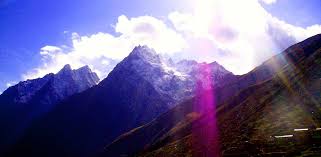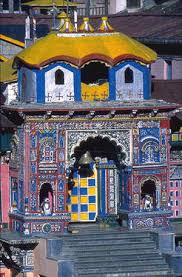JAI BADRINATH KI!!
JAI GANGA MATA KI !!'
At Badrikashram, Narayana parvat is, where the temple of Sri Badrinath is. It is tall and long. Opposite, across Alakananda, is Nara parvat. All the mountains, the river and the Sun present a kaleidoscope effect! Beauty varies each time, like early morning, morning, noon and evening. The natural beauty changes, just as decorations for Sri Badri Narayana is changed!


URVASI TEMPLE
We have to see Four important mountains here. We have seen Narayana and Nara mountains, opposite to each other. Then there is Urvasi [or Oorvasi] parvat, where the Lord created Urvasi, the beautiful damsel of heaven. She emerged from the thigh of the Lord [ooru ऊरू means thigh in Sanskrit]. Behind Urvasi mountain is Nilakanta parvat, covered by snow. When Sun rises behind this mountain, we see the brilliant rays. Beyond this mountain is Charana Paduka.

There we can see foot prints of the Lord and a Rakshasa. A legend is heard among the locals here. Many Thousands of years back a Rakshasa lived here. His name was Sahasra Kavacha Rakshasa! He had 10,00o armours [kavacha = armour]. They were unbreakable normally and only after 10,000 years of meditation, one could break one kavacha! With this boon, he was undestroyable! Once the Rakshasa tried to fight with Sri Nara and Sri Narayana, who were meditating here. Since the sanctity of Badrikashram was such that one day's meditation was equal to 10,000 years of meditation, Sri Nara and Sri Narayana planned to take on the Rakshasa alternately! When Sri Nara was meditating on one day, Sri Narayana would fight with the Rakshasa and break one kavacha; and on another day, when Sri Narayana was on meditation, Sri Nara would fight the Rakshasa and break another kavacha! Thus, both of Them, destroyed 9,999 kavachas of the Rakshasa, in 9999 days! The Rakshasa then fled the place with his only remaining kavacha! It is heard as part of the legend, that the Rakshasa was born as Karna with the remaining single kavacha, in Dwapara yug, when Sri Krishna appeared! These foot prints are the evidence of the fight between the Lord and the Rakshasa! Why was Urvasi created? After all her duty was to disturb the meditation of other persons, so that Indra was safe with his power! Should Lord create a woman for this? Alwar says that we have to worship the Lord at Badarikashram, after discarding sensual pleasures. We are aware that as we grow older, our limbs need support and many physical problems arise. Alwar says that therefore, before we reach old age and suffer, we should come to Badarikashram! In our youth we have many distractions like Urvasi and others, and prevent us from coming to this place. The Lord has created sacred places and made available facilities to cultivate good habits. If we are firm in those qualities, then no Urvasi or Rambha or any other, could disturb us! Arjuna was steady in his qualities and that is why he saw Urvasi as his mother and respected! He is an example for success! This place is meant to enjoy the Lord and cultivate satva quality. Now, we will see what the Lord says in sloka 20:
dātavyam iti yad dānaṃ dīyatenupakāriṇe
deśe kāle ca pātre ca tad dānaṃ sāttvikaṃ smṛtam 17.20
The Lord is going to describe satvika dhanam, rajasa dhanam and tamasa dhanam in the Three slokas 20, 21 and 22. [Dhanam = philanthropy or charity]. We assume that dhanam is given to poor and lower people. This assumption is wrong. By receiving dhanam one is not lower; nor the donor is higher. No doubt the philanthropist raises in esteem; but by no means the receiver is lower. As ordained by Manu and in shastras, dhanam is recommended. By doing so the donor gets punya. If there was no receiver, then how anyone could get punya by dhanam? The Lord says that such and such persons should receive and some others to donate. But our charity could be satvika type, by donating at the right place and at the right time to right persons! As mentioned earlier, in this place a dhanam made gets punya of 10 Million times dhanam made! Yad dhanam = that dhanam, diyate = donated, datavyam iti = according to dharma shastras. We have to donate as prescribed in shastras and with pleasure. Mere following of shastras is not enough. We should be happy and follow shastras. This alone should be our objective and nothing else. To whom such dhanam is to be made? Anupakarine = to that person who had not helped us in the past or who is likely to favour us in the future. We should not show charity as a reciprocation of a favour received in the past; or, we should not donate to someone with the hope that he might help us in the coming days. Such dhanam even if done in Badarikashram is not satvika dhanam. Dese = [dhanam should be made] in proper place, kale = at proper time, ca patre = and to proper person(s). For example, donating cows [godhan] in Ayodhya on the banks of Sarayu river is recommended. Similarly, at all sacred places. Here is Badarikashram, we find fish in the river. Feeding them is good. We will later on see in which places we should not do dhanam. Proper times are prescribed. Like, for example Uttarayana punya kalam [beginning of Thai month] or dakshinayana punya kalam [beginning of Aadi month], etc. Receiver of dhanam is patram and he should be qualified to receive. Mere birth in a family or being learned, alone will not qualify. Receiver should have proper character. Giving dhanam like this is called satvika dhanam, says Sri Krishna.










